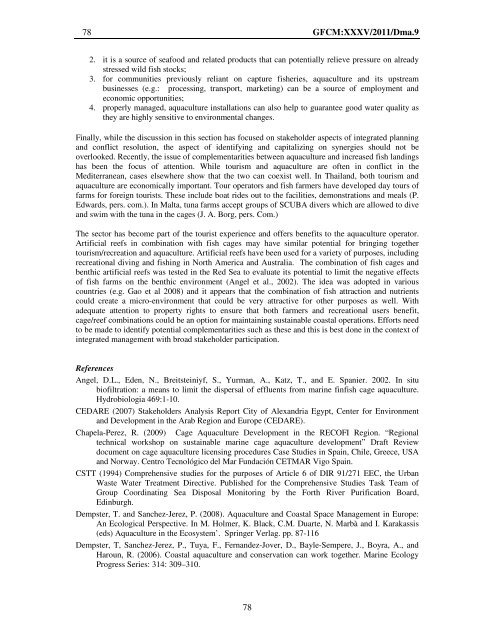Site selection and carrying capacity in Mediterranean ... - FAO Sipam
Site selection and carrying capacity in Mediterranean ... - FAO Sipam
Site selection and carrying capacity in Mediterranean ... - FAO Sipam
Create successful ePaper yourself
Turn your PDF publications into a flip-book with our unique Google optimized e-Paper software.
78 GFCM:XXXV/2011/Dma.9<br />
2. it is a source of seafood <strong>and</strong> related products that can potentially relieve pressure on already<br />
stressed wild fish stocks;<br />
3. for communities previously reliant on capture fisheries, aquaculture <strong>and</strong> its upstream<br />
bus<strong>in</strong>esses (e.g.: process<strong>in</strong>g, transport, market<strong>in</strong>g) can be a source of employment <strong>and</strong><br />
economic opportunities;<br />
4. properly managed, aquaculture <strong>in</strong>stallations can also help to guarantee good water quality as<br />
they are highly sensitive to environmental changes.<br />
F<strong>in</strong>ally, while the discussion <strong>in</strong> this section has focused on stakeholder aspects of <strong>in</strong>tegrated plann<strong>in</strong>g<br />
<strong>and</strong> conflict resolution, the aspect of identify<strong>in</strong>g <strong>and</strong> capitaliz<strong>in</strong>g on synergies should not be<br />
overlooked. Recently, the issue of complementarities between aquaculture <strong>and</strong> <strong>in</strong>creased fish l<strong>and</strong><strong>in</strong>gs<br />
has been the focus of attention. While tourism <strong>and</strong> aquaculture are often <strong>in</strong> conflict <strong>in</strong> the<br />
<strong>Mediterranean</strong>, cases elsewhere show that the two can coexist well. In Thail<strong>and</strong>, both tourism <strong>and</strong><br />
aquaculture are economically important. Tour operators <strong>and</strong> fish farmers have developed day tours of<br />
farms for foreign tourists. These <strong>in</strong>clude boat rides out to the facilities, demonstrations <strong>and</strong> meals (P.<br />
Edwards, pers. com.). In Malta, tuna farms accept groups of SCUBA divers which are allowed to dive<br />
<strong>and</strong> swim with the tuna <strong>in</strong> the cages (J. A. Borg, pers. Com.)<br />
The sector has become part of the tourist experience <strong>and</strong> offers benefits to the aquaculture operator.<br />
Artificial reefs <strong>in</strong> comb<strong>in</strong>ation with fish cages may have similar potential for br<strong>in</strong>g<strong>in</strong>g together<br />
tourism/recreation <strong>and</strong> aquaculture. Artificial reefs have been used for a variety of purposes, <strong>in</strong>clud<strong>in</strong>g<br />
recreational div<strong>in</strong>g <strong>and</strong> fish<strong>in</strong>g <strong>in</strong> North America <strong>and</strong> Australia. The comb<strong>in</strong>ation of fish cages <strong>and</strong><br />
benthic artificial reefs was tested <strong>in</strong> the Red Sea to evaluate its potential to limit the negative effects<br />
of fish farms on the benthic environment (Angel et al., 2002). The idea was adopted <strong>in</strong> various<br />
countries (e.g. Gao et al 2008) <strong>and</strong> it appears that the comb<strong>in</strong>ation of fish attraction <strong>and</strong> nutrients<br />
could create a micro-environment that could be very attractive for other purposes as well. With<br />
adequate attention to property rights to ensure that both farmers <strong>and</strong> recreational users benefit,<br />
cage/reef comb<strong>in</strong>ations could be an option for ma<strong>in</strong>ta<strong>in</strong><strong>in</strong>g susta<strong>in</strong>able coastal operations. Efforts need<br />
to be made to identify potential complementarities such as these <strong>and</strong> this is best done <strong>in</strong> the context of<br />
<strong>in</strong>tegrated management with broad stakeholder participation.<br />
References<br />
Angel, D.L., Eden, N., Breitste<strong>in</strong>iyf, S., Yurman, A., Katz, T., <strong>and</strong> E. Spanier. 2002. In situ<br />
biofiltration: a means to limit the dispersal of effluents from mar<strong>in</strong>e f<strong>in</strong>fish cage aquaculture.<br />
Hydrobiologia 469:1-10.<br />
CEDARE (2007) Stakeholders Analysis Report City of Alex<strong>and</strong>ria Egypt, Center for Environment<br />
<strong>and</strong> Development <strong>in</strong> the Arab Region <strong>and</strong> Europe (CEDARE).<br />
Chapela-Perez, R. (2009) Cage Aquaculture Development <strong>in</strong> the RECOFI Region. “Regional<br />
technical workshop on susta<strong>in</strong>able mar<strong>in</strong>e cage aquaculture development” Draft Review<br />
document on cage aquaculture licens<strong>in</strong>g procedures Case Studies <strong>in</strong> Spa<strong>in</strong>, Chile, Greece, USA<br />
<strong>and</strong> Norway. Centro Tecnológico del Mar Fundación CETMAR Vigo Spa<strong>in</strong>.<br />
CSTT (1994) Comprehensive studies for the purposes of Article 6 of DIR 91/271 EEC, the Urban<br />
Waste Water Treatment Directive. Published for the Comprehensive Studies Task Team of<br />
Group Coord<strong>in</strong>at<strong>in</strong>g Sea Disposal Monitor<strong>in</strong>g by the Forth River Purification Board,<br />
Ed<strong>in</strong>burgh.<br />
Dempster, T. <strong>and</strong> Sanchez-Jerez, P. (2008). Aquaculture <strong>and</strong> Coastal Space Management <strong>in</strong> Europe:<br />
An Ecological Perspective. In M. Holmer, K. Black, C.M. Duarte, N. Marbà <strong>and</strong> I. Karakassis<br />
(eds) Aquaculture <strong>in</strong> the Ecosystem’. Spr<strong>in</strong>ger Verlag. pp. 87-116<br />
Dempster, T, Sanchez-Jerez, P., Tuya, F., Fern<strong>and</strong>ez-Jover, D., Bayle-Sempere, J., Boyra, A., <strong>and</strong><br />
Haroun, R. (2006). Coastal aquaculture <strong>and</strong> conservation can work together. Mar<strong>in</strong>e Ecology<br />
Progress Series: 314: 309–310.<br />
78
















